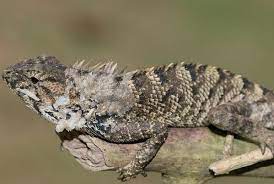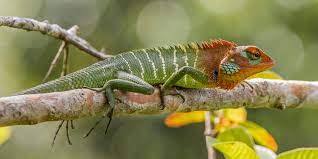Description

Disclaimer: Copyright infringement not intended.
Context
- Researchers have described a new species of the genus Calotes from southern China and northern Vietnam.
Details
- Named the Wang’s Garden lizard (Calotes wangi), the new species is less than 9 cm long, and one of its distinguishing features is its orange tongue.
- Calotes wangi is found in subtropical evergreen broad-leaved forests and tropical monsoon forests in southern China and northern Vietnam, mostly in mountainous areas, hills and plains on forest edges, arable land, shrub lands, and even urban green belts.
- It is active at the edge of the forest, and when it is in danger, it rushes into bushes or climbs tree trunks to hide.
- Investigations found that the lizards lie on sloping shrub branches at night, sleeping close to the branches.
- Calotes wangi is active from April to October every year, while in the tropics it is active from March to November or even longer, and eats a variety of insects, spiders, and other arthropods.
- The researchers estimate that the new species is not threatened, but they do note that in some areas its habitat is fragmented.
- In addition, their bodies are used medicinally and the lizards are also eaten.
- The genus Calotes comprises a group of arboreal lizards belonging to the family Agamidae. These lizards are commonly known as "forest lizards" or "garden lizards."
- The genus Calotes is distributed across various regions in Asia, and it includes a diverse array of species. Here are some general details about the genus Calotes:
Calotes Genus
Taxonomy:
- Family: Agamidae
- Subfamily: Draconinae
- Genus: Calotes

Characteristics:
Size:
- Calotes species vary in size, with some reaching lengths of around 15 to 90 centimeters, depending on the species.
Coloration:
- Many Calotes species exhibit vibrant and varied coloration, often with a combination of greens, blues, reds, and yellows.
- The coloration may change based on factors such as mood, temperature, or breeding status.
Crests and Appendages:
- Some species have prominent crests on their heads or along their bodies.
- Males of certain species may have dewlaps or throat pouches that are used in displays during courtship or territorial behavior.
Habitat:
- Calotes species are predominantly arboreal, meaning they primarily inhabit trees and vegetation.
- They are often found in diverse habitats, including forests, shrublands, gardens, and urban areas.
Behavior:
- Calotes are diurnal, meaning they are active during the day.
- They are agile climbers and often bask in the sun on tree branches or other elevated surfaces.
- Territorial behavior is common, especially among males during the breeding season.
Diet:
- Their diet primarily consists of insects, small vertebrates, and occasionally plant matter.
Reproduction:
- Calotes species typically lay eggs, and the females may bury them in the ground or hide them in vegetation.
- Mating behaviors often involve colorful displays by the males.
Distribution:
- The genus Calotes is distributed across a wide range of countries in Asia, including India, Sri Lanka, Southeast Asia, parts of China, and Indonesia.
Notable Species:
Calotes versicolor (Changeable Lizard):
- Found in a variety of habitats, including gardens and urban areas.
- Exhibits remarkable color changes.
Calotes grandisquamis (Green Forest Lizard):
- Known for its bright green coloration.
- Found in forested habitats.
Calotes mystaceus (Blue Crested Lizard):
- Recognized for its blue coloration.
- Inhabits forested areas.
Conservation Status:
- The conservation status of Calotes species varies, and some may face threats such as habitat loss due to urbanization, agriculture, or logging.

|
PRACTICE QUESTION
Q. Consider the following statements:
1. Calotes species are predominantly arboreal, meaning they primarily inhabit trees and vegetation.
2. Calotes are nocturnal, meaning they are active during the night.
3. Calotes species typically lay eggs, and the females may bury them in the ground or hide them in vegetation.
Which of the above statements is/are incorrect?
A) 1 only
B) 2 only
C) 2 and 3 only
D) None
Answer: D) None
|











